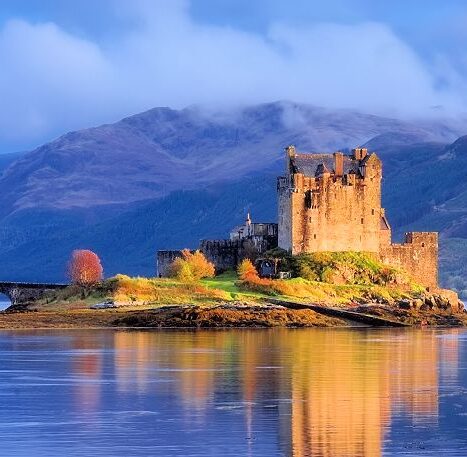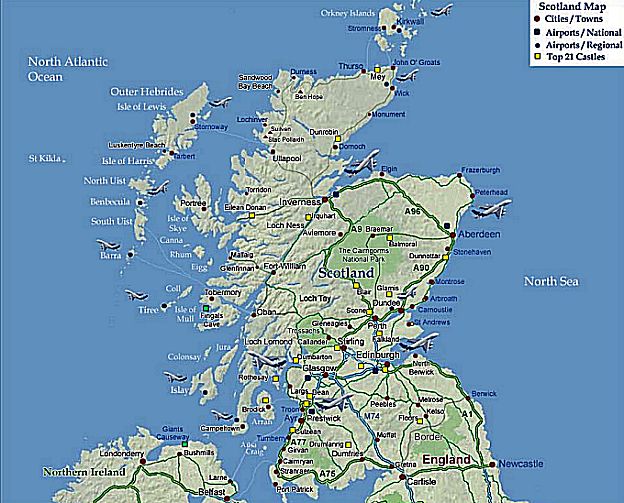
Scotland a great country, but if you are from Scotland then it is known as the greatest country on the planet.
God gave us memory so that we might have roses in December.
J.M. Barrie
Let us do or die.
Robert Burns
Don’t be penny wise and pound foolish.
Scottish Proverb
A well-written life is almost as rare as a well-spent one.
Thomas Carlyle
Our grand business is not to see what lies dimly at a distance, but to do what lies clearly at hand.
Thomas Carlyle
Everywhere in life, the true question is not what we gain, but what we do.
Thomas Carlyle
Practical wisdom is only to be learned in the school of experience. Precepts and instruction are useful so far as they go, but, without the discipline of real life, they remain of the nature of theory only.
Samuel Smiles
History is the essence of innumerable biographies.
Thomas Carlyle
Man is an animal that makes bargains; no other animal does this – one dog does not change a bone with another.
Adam Smith
If time is precious, no book that will not improve by repeated reading deserves to be read at all.
Thomas Carlyle
In the long-run every Government is the exact symbol of its People, with their wisdom and unwisdom; we have to say, Like People like Government.
Thomas Carlyle
To be trusted is a greater compliment than to be loved.
George MacDonald

To have what we want is riches; but to be able to do without is power.
George MacDonald
We die daily. Happy those who daily come to life as well.
George MacDonald
You can’t live on amusement. It is the froth on water – an inch deep and then the mud.
George MacDonald
Because Scotland and Northern Ireland want to remain part of the E.U., there is the quite real possibility that Scotland and even Northern Ireland might now choose to go their own way on membership within the E.U. and the ‘United Kingdom’ would suddenly effectively be only England and Wales.
Peter Bergen
Scotland is one of the four national units that make up the United Kingdom of Great Britain and Northern Ireland. The other units are England, Northern Ireland, and Wales. Edinburgh is the capital of Scotland, and Glasgow is its largest city. Scotland can be one of the most beautiful and fascinating of travel destinations. The stunning landscape and rich history could keep a holidaymaker happy for months, so long as he or she isn’t the type that likes doing nothing but lying on the beach. Even so, Scotland does have more than its fair share of sea and sand; it’ s just a little short on the sun.
Scotland and its offshore islands comprise the northernmost part of the United Kingdom. The Scottish mainland, which occupies roughly the northern third of the island of Great Britain, is bordered on three sides by seas. To the north and west is the Atlantic Ocean; to the east is the North Sea. Rugged uplands separate Scotland from England to the south. The territory of Scotland includes 186 nearby islands, a majority of which are contained in three groups. These are the Hebrides, also known as the Western Isles, located off the western coast; the Orkney Islands, located off the northeastern coast; and the Shetland Islands, located northeast of the Orkney Islands. The largest of the other islands is the Island of Arran. The total land area of Scotland, including the islands, is 78,790 sq km (30,420 sq mi).
An independent nation for much of its history, Scotland was joined to England by a series of dynastic and political unions in the 17th and 18th centuries. Scotland retains a separate national identity, however, supported by separate legal and educational systems, a national church, a parliament with wide-ranging powers, and other national symbols and institutions.
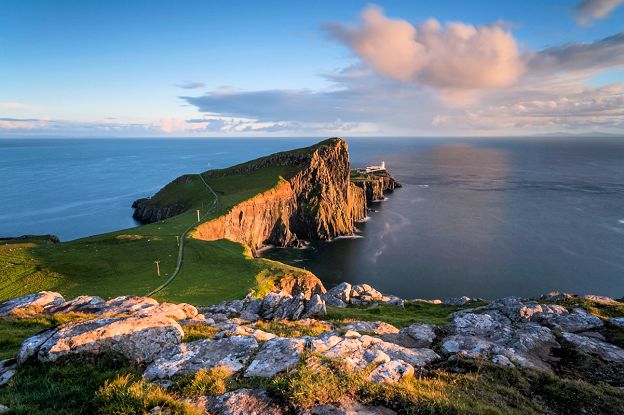
The terrain of Scotland is predominantly mountainous but may be divided into three distinct regions, from north to south: the Highlands, the Central Lowlands, and the Southern Uplands. More than one-half of the land in Scotland is occupied by the Highlands, the most rugged region on the island of Great Britain and the least densely inhabited part of Scotland. The Highlands contain two parallel mountain chains that run roughly northeast to southwest. The rocky summits of the Highlands were carved by ancient glaciers and centuries of rain. Broken by deep ravines and valleys, the region is noted for its scenic grandeur. Precipitous cliffs, moorland plateaus, mountain lakes, sea lochs, swift-flowing streams, and dense thickets are common to the Highlands.
Ben Nevis, in western Scotland’s Grampian Mountains, is the tallest mountain in the British Isles and a popular tourist destination. More than 300 million years of erosion have rounded the top of the mountain, once a lofty volcano. Loch Linnhe can be seen here in the foreground, with the town of Fort William on its south shore, at the foot of Ben Nevis.
The Tweed river rises in Scotland’s Southern Uplands and runs eastward, forming part of the border with England before entering the North Sea. The valley of the Tweed, and the region surrounding the river’s many tributaries, is fertile farmland. The area is noted for its sheep and for the production of woolen tweed cloth. The Tweed is shallow and fast-flowing, ideal for the salmon and trout that make it a famous fly-fishing river.
Scotland is endowed with an abundance of streams and lakes. Most lakes are long and narrow. Notable among the lakes, which are especially numerous in the central and northern regions, are Loch Lomond, the longest lake in Scotland; Loch Ness, which according to legend contains a sea monster; Loch Tay; and Loch Katrine.
Loch Lomond is the largest of the glacially excavated lochs, or lakes, in Scotland. Beautiful scenery and boat trips attract many tourists in the summer season.
Many of the rivers of Scotland, especially those in the west, are short, torrential streams, with limited commercial importance. The longest river of Scotland is the Tay. The Clyde, which flows through the city of Glasgow and through the industrial heartland, is Scotland’s most important river and serves as a transportation outlet to the Atlantic Ocean. Other important rivers in Scotland flow east and drain into the North Sea. They include the Forth, Tweed, Dee, and Esk.
Like the rest of the United Kingdom, the climate of Scotland is subject to the moderating influences of the surrounding seas. Temperate winters and cool summers are typical, and extreme seasonal variations are rare. Low temperatures, however, are common in mountainous parts of the interior during the winter months. In the western coastal region, where the moderating effects of the Gulf Stream are strongest, conditions are somewhat milder than in the east.
The average January temperature of the eastern coastal region is 3°C (37°F), and the average January temperature of the western coastal region is 4°C (39°F); corresponding July averages are 14°C (57°F) and 15°C (59°F). The average January and July temperatures for the city of Edinburgh are 3°C (38°F) and 14°C (58°F), respectively. Precipitation varies by region and topography and ranges from about 3,800 mm (about 150 in) annually in the western Highlands to about 635 mm (about 25 in) annually in some eastern areas.

Scotland, like the rest of the island of Great Britain, has significant reserves of coal. It also possesses large deposits of zinc, chiefly in the south. Much of the soil is rocky and infertile, with the best arable land concentrated in the Central Lowlands and in flat eastern coastal areas. In the north and west, where the climate is wetter and soils are less productive, forestry and sheep raising are important.
Vast oil reserves were discovered in the North Sea off the Scottish coast in the 1960s and large-scale drilling began in the 1970s. Scotland has an intensive waterpower development program to increase energy supplies. The rivers of northern Scotland provide significant quantities of hydroelectric power, and the region contains most of the United Kingdom’s hydroelectricity-generating capacity.
The people of Scotland, like those of the United Kingdom in general, are descendants of various ethnic stocks, including the Picts, Celts, Scandinavians, Anglo-Saxons, and newer immigrant groups. Scotland is mainly an urban-industrial society with a small, sparsely scattered rural population. Large-scale internal migration during the 19th and 20th centuries weakened the historic regional distinctions between Highlander (primarily Celtic, Catholic, and Gaelic-speaking) and Lowlander (Anglo-Saxon, Protestant, and Scots-speaking). In the 20th century the arrival of immigrants from former British colonial territories, as well as from other parts of the United Kingdom, has created a culturally diverse population, especially in the two main urban areas of Glasgow and Edinburgh.
The population of Scotland (2004 estimate) is 5,078,000. The population density is about 64 persons per sq km (167 per sq mi), making Scotland the most sparsely populated of the major United Kingdom administrative divisions. The highest density is in the Central Lowlands, where nearly three-quarters of all Scots live, and the lowest is in the Highlands. About two-thirds of the population resides in urban areas.
Scotland’s total population has remained almost unchanged since 1900. This stability is a result of low birth rates throughout the 20th century and steady rates of emigration to destinations overseas and to neighboring England.
Glasgow (population, 2001, 578,700) is Scotland’s largest city. It forms part of the metropolis of Clydeside, which is composed of a large number of urban areas, including Clydebank, Paisley, Kilmarnock, and Hamilton. This region is the main industrial and commercial center in Scotland. Edinburgh (449,000) is the capital of Scotland and also the country’s major administrative and financial center. The city is Scotland’s main tourist destination and hosts the Edinburgh International Festival, the largest annual arts festival in the United Kingdom. Other major cities are Aberdeen (211,300), a center for oil production and distribution, and Dundee (150,250).
The Church of Scotland, a Presbyterian denomination, is the official state church (see Scotland, Church of). Approximately 70 percent of the population is Protestant. Most of the rest of the population belongs to the Roman Catholic Church. Other important denominations are the Episcopal Church in Scotland, Congregationalist, Baptist, Methodist, and Unitarian. Immigration in the 19th and 20th centuries contributed new religious groups, including Jews, Hindus, Muslims, and Buddhists.
English is the main language spoken in Scotland, although 30 percent of the population claims to use the Scottish language, a dialect of the English language. Fewer than 100,000 Scots (mainly inhabitants of the Highlands and island groups) also speak the Scottish form of Gaelic, part of the family of Celtic languages. However, Gaelic has enjoyed a revival in Scotland in recent years. Today, there are more than 2,000 children in Gaelic immersion schools, primarily in the Hebrides and Glasgow. There is also a Gaelic language college, Sabhal Ostaig Mor, located on the Isle of Skye.
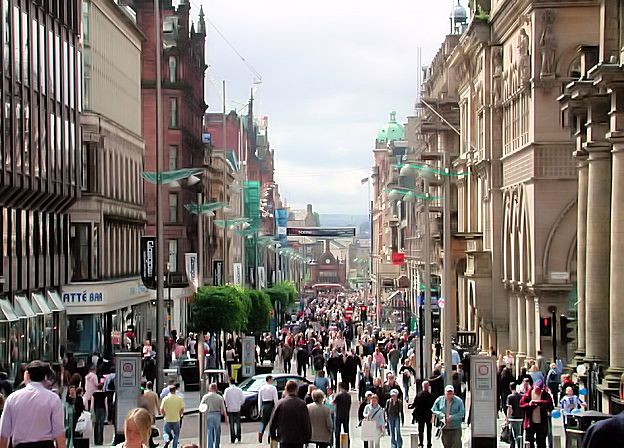
Customs of Scotland
People usually marry in their middle to late 20s. Many couples live together before or instead of marriage. Marriage customs are much the same as elsewhere in the United Kingdom.
Early families living in the Scottish Highlands were loyal to their clan, a unit that bound together relatives sharing a common ancestor or some other bond of loyalty. However, clans have less importance in the lives of individual family members today. Each clan is still headed by a chieftain, but the position is mainly symbolic. Contemporary members of a clan may make efforts to preserve its traditions and history. Each clan is represented by a tartan, a distinctive plaid pattern.
In rural areas, the extended family can still be important, but in urban areas families tend to be small and generally close-knit. Although relatives visit each other often, families are independent from each other. The elderly prefer to stay in their own homes and remain independent as long as possible, rather than live with their married children. Just over half of all homes are owner occupied, the lowest level in the United Kingdom.
The traditional breakfast includes porridge (oats mixed with boiled milk or water and served with sugar or, more properly, salt). Many people now prefer other cereals to porridge and have forsaken a cooked meal in the morning. A wide variety of meat and fish is available, and the Scots eat many foods found elsewhere in Europe and other parts of the world. The Indian restaurants in Glasgow are particularly well respected. Traditionally, the Scots have favored wholesome meals such as stews, eaten with vegetables such as neeps (turnips) and tatties (potatoes). The national dish is haggis, which is made from ground sheep entrails, mixed with oats and spices, and tied in a sheep’s stomach and cooked. Younger Scots typically eat less of this traditional fare. The national drink is whiskey (spelled ‘whisky’ in Scotland), the production of which contributes significantly to the economy.
The Scots generally eat three meals a day. Most younger people eat their main meal in the evening, while older Scots may have it in the middle of the day. The evening meal, particularly if it is eaten quite early, is sometimes called tea.
A handshake is usual when people are introduced, and standard English greetings such as “Hello” and “How do you do?” are common. More informal greetings among friends include “All right?” and, in the north, “Fit like?,” to which the response is Nae sae bad (“Not so bad”), or “All right.”
In Scotland, visits to the home are usually prearranged. Only close friends and family drop by unannounced.
The most popular organized sport is soccer, followed by rugby, but a wide range of sports are enjoyed. Many people play golf, which was devised in Scotland in the 14th or 15th century, and the country has many excellent courses. Scotland is also famous for its fishing. Winter sports include curling (in which two teams of four players slide granite “stones” over ice to reach a target) and skiing. Scotland is the only part of the United Kingdom where it is possible to ski, although the snow conditions are not that reliable.
Highland Games are held in many parts of the Scottish Highlands during the summer. They are a traditional kind of track and field meeting where the events include tossing the caber (a roughly trimmed tree trunk) and throwing the hammer (a heavy metal ball attached to a chain). Participants often wear traditional dress, and musicians play traditional bagpipe music.
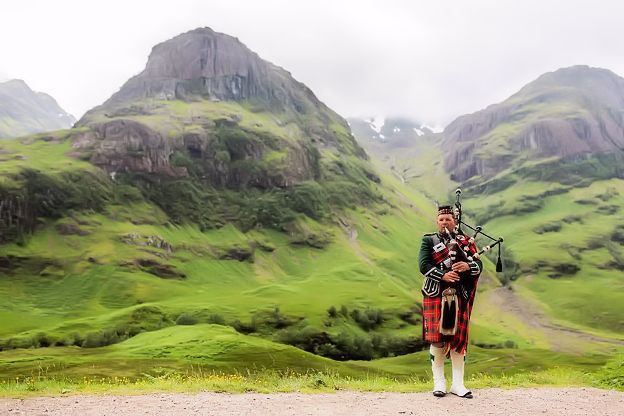
Watching television and going to the cinema are also favorite leisure activities. Pubs – public houses that serve alcoholic beverages and sometimes food—are probably the most popular venues outside the home for socializing.
Scotland’s national holidays are slightly different from those in England and Wales. They include New Year’s Day (1 January), Good Friday (the Friday preceding Easter), May Day (the first Monday in May), Spring Bank Holiday (the last Monday in May), August Bank Holiday (the first Monday in August), and Christmas Day (25 December). New Year’s Eve (Hogmanay) is when some of the year’s most lively celebrations take place.
Traditionally, on Hogmanay, children would go to the doors of their neighbors, and sing and cry out “Hogmanay!” to receive oatmeal cakes in return. Another tradition associated with New Year’s Eve is the “first-footer,” or the first person to cross the threshold of a home after midnight on New Year’s Eve. If the first-footer is a dark-haired man carrying presents, the family should have good luck for the rest of the year. The song “Auld Lang Syne,” by beloved Scottish poet Robert Burns, is sung on New Year’s Eve.
Many Scots honor Burns’s birthday (25 January) by celebrating his life and works at Burns Suppers, where haggis is served. Saint Andrew’s Day, on 30 November, honors the patron saint of Scotland. Some Scots wear a blue-and-white X on this day to symbolize the cross upon which Saint Andrew was crucified by the Romans. This X-shaped cross has become a patriotic symbol.
There has been a recent revival in the popularity of wearing kilts on special occasions. Men might wear them for events such as graduations, weddings, or Hogmanay.
Industrial contraction, along with the decline of the United Kingdom as a world power in the decades after World War II, contributed to the rise of Scottish nationalist sentiment in the mid-1970s. The discovery of oil in Scottish territorial waters also contributed to Scottish nationalism by fueling hopes of economic self-sufficiency. In 1974 the Scottish National Party (SNP) gained 11 of Scotland’s 72 seats in the British Parliament. In an effort to moderate rising Scottish nationalism, the Labour government called a referendum to grant Scotland its own elected assembly with limited executive and legislative authority.
When the referendum was held in March 1979, a majority of Scots who voted endorsed the plan. However, the plan did not gain approval by 40 percent of eligible voters, the minimum required, so the referendum failed and the assembly was abandoned. A few months later the Labour government fell, and the new Conservative government abandoned all plans for any form of Scottish self-government. (Read what happened afterwards in the next post.)
So we can conclude this short article with the Scottish song that is sung the world over at the close of parties, conferences and all kinds of pleasant occasions, but particularly at midnight on what the Scots call Hogmanay – the 31st of December, known to the rest of the world as New Year’s Eve. “Should auld acquaintance be forgot And never brought to mind Should auld acquaintance be forgot And days of auld lang syne. For auld lang syne, my dear, For auld lang syne, We’ll take a cup of kindness yet For auld lang syne.” The original words in Scottish dialect are by Robert Burns, and they mean “Let’s not forget old friends, nor good times in the past… let’s drink a toast to one another, for old time’s sake”.
If you want to find out more about Scotland you can also read:

